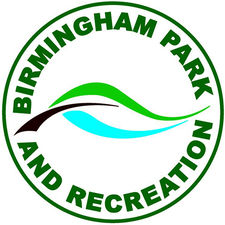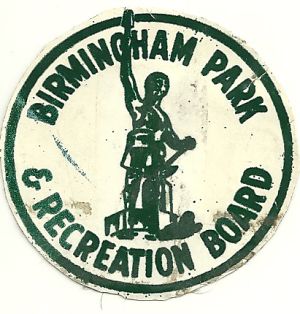Birmingham Park and Recreation Board
The Birmingham Park and Recreation Board is an administrative agency of the city of Birmingham charged with establishing park and recreation facilities and programs, hiring and supervising park workers, and entering into contracts and leases on behalf of the city. Currently the board manages 124 properties, totaling more than 2,000 acres, including golf courses, tennis courts, swimming pools, fishing lakes, athletic fields, recreation centers and picnic shelters.
The five board members must reside in the city, and are appointed to four-year terms by the Birmingham City Council. The current director is Shonae Eddins-Bennett.
History
By 1923 the city owned about 600 acres of park land. The acreage and the use of it was determined to be inadequate to serve the needs of the rapidly-growing city. The initiative to establish a park board to take charge of maintaining, improving and expanding the city's parks was pressed by M. Paul Phillips, president of the Steel City Lumber Company, through a committee of the Kiwanis Club of Birmingham. Phillips corresponded with nationally-known park planner Frederick Law Olmsted, Jr and his committee successfully lobbied the Alabama State Legislature to pass a law allowing Birmingham to establish a park board.
The Birmingham Park and Recreation Board was organized on October 1, 1923 with James Dupuy as president and Phillips as vice president. They were joined by Elmer Thuston, William Harrison and Mrs Charles Sharp. In order to guide its efforts, the board commissioned the Olmsted Brothers landscape architects of Brookline, Massachusetts to survey the city's existing parks and potential park sites and to make recommendations for the development of park areas for the benefit of residents. The result, entitled "A Park System for Birmingham", was prepared in 1924, primarily by Edward Clarke Whiting, and published by the board on May 1, 1925. As the title suggests, the plan envisioned a comprehensive system of parks and dedicated recreation and scenic preserves. The Olmsteds did not limit their study to areas within the city limits, but made recommendations for areas of special interest or vulnerability across Jefferson County.
Some specific recommendations of the plan were implemented, such as the creation of a government center surrounding Woodrow Wilson Park and the development of Rushton Park and Underwood Park. Other major recommendations, such as the acquisition of tracts in the Village Creek flood plain, in Shades Valley, and on the ridge of Red Mountain, were not implemented, partly due to the loss of momentum following Phillips' death and the ravages of the Great Depression.
In 1939 the board recommended employing 12 or 14 night watchmen to protect park equipment from vandalism and theft, but were only able to pay for 4.
On January 15, 1962 U.S. District Court judge Hobart Grooms ruled that Birmingham could not continue to operate its city parks on a segregated basis. The Birmingham City Commission and park director Frank Wagner decided to close the parks rather than desegregate. Excluded from the closure were Woodrow Wilson Park, Vulcan Park, Legion Field, the Birmingham Zoo, Birmingham Botanical Gardens, and the park department's greenhouse at Green Springs Park. All park pools and recreation centers were also closed, and recreation superintendent Tommy Jones resigned in September.
Soon, at the suggestion of E. M. Danenburg of the Birmingham Chamber of Commerce, the board began granting specific use permits for Little League teams and other organized groups wishing to use park facilities. The Alabama Christian Movement for Human Rights complained to Mayor Art Hanes that the permit system was discriminatory, but Wagner claimed that black groups were issued permits on an equal basis as whites.
Public golf courses reopened on June 29, 1963 on an integrated basis. The newly-installed Birmingham City Council voted to reopen city parks for all residents on July 23. In 1968 the city received a grant from the U.S. Department of Housing and Urban Development to construct fourteen new swimming pools. Ten of them opened the following year amid protests from residents of predominantly-white neighborhoods who objected to the likelihood of the pools attracting black children. Birmingham Police officer Kenneth Spencer was shot to death with his own service weapon during a melee that broke out when he tried to evict a group of black teenagers from Harris Park pool in Ensley Highlands. All city-owned pools were closed for the remainder of the year and reopened, with additional rules to prevent overcrowding, in 1970.
Currently, the park board operates 124 parks, recreation centers, swimming pools, and special landscaping areas throughout the city. Decisions and policies of the board are executed by the Executive Director, Melvin Miller, and his staff. Their offices are located inside Legion Field at 400 Graymont Avenue. Park board employees are hired under the Personnel Board of Jefferson County. All actual real estate is the property of the city.
Board controversies
In February 2006, the Birmingham City Council appointed three new members to the Park and Recreation Board. On March 1, the Board refused to allow the new members to take their seats, citing a lack of diversity in replacing Boyce Higgins, the only white member, with Brendette Brown Green, a black woman. The Board referred to its 1923 charter, stating it had the right to reject members appointed by the City Council. The three outgoing Board members vowed to stay until the City Council had more racial diversity in their appointments.
On April 4 the City Council offered a compromise in which Green and Theodore L. Smith would join the Board, replacing Frederick Love and Calvin Haynes; Higgins would be reappointed to serve another term until February 2007; and Ronald Mitchell's nomination would be withdrawn. The Board voted on April 19 to accept Green as a replacement for Love. The vote to accept Smith in place of Haynes was delayed briefly because Smith was not present at the meeting, but he was ultimately accepted as well.
As a result of the situation, the City Council has asked the Alabama legislature to abolish the rule allowing the Park and Recreation Board to refuse their appointments.
Directors
- Roy Marshall, 1925-1943
- King Sparks, 1946-1961
- Frank Wagner, 1961-1987
- Melvin Miller, 1987-2012
- Kevin W. Moore, 2014-
- Shonae Eddins-Bennett, June 2018-
Board members
1937
- Thomas Bowron, president
1938
- Karl Landgrebe, president
- Laura Sharp, vice president
1942
- James Downey, president
- Laura Sharp
- Charles Harris
- Charles Baily
1961
- James Downey, president
- Mrs J. H. Berry
- Dan Gaylord
- Art Hanes
- Jimmy Morgan
1972
- Carl Salter, president
- Thomas Bradford
- J. Arthur Jordan
- Don Hawkins
- Frank Samford Jr
- James Downey, emeritus
1978
- J. Arthur Jordan, president
- Joe Davis, vice-president
1983
current
- Ronald D. Mitchell, president
- William Parker, vice-president
- Larry Cockrell
- Bernard Kincaid
- Theodore L. Smith
See also
References
- Birmingham Park and Recreation Board (May 1, 1925) A Park System for Birmingham, republished in 2005 by the Birmingham Historical Society
- "Park board won't let appointees take seats." (March 2, 2006) The Birmingham News
- "Compromise OK'd on appointments to city park board." (April 5, 2006) The Birmingham News
- "Council, park board end fight over picks." (April 20, 2006) The Birmingham News
- Bryant, Joseph D. (January 29, 2007). "Parker pushes rules limiting Park Board power." The Birmingham News

